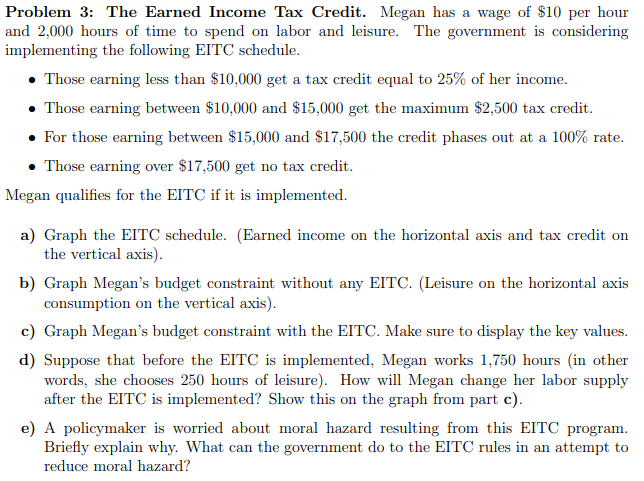
Problem 3: The Earned Income Tax Credit. Megan has a wage of $10 per hour and 2,000 hours of time to spend on labor and leisure. The government is considering implementing the following EITC schedule. Those earning less than $10,000 get a tax credit equal to 25% of her income. Those earning between $10,000 and $15,000 get the maximum $2,500 tax credit. For those earning between $15,000 and $17,500 the credit phases out at a 100% rate. Those earning over $17,500 get no tax credit. Megan qualifies for the EITC if it is implemented. a) Graph the EITC schedule. (Earned income on the horizontal axis and tax credit on the vertical axis). b) Graph Megan's budget constraint without any EITC. (Leisure on the horizontal axis consumption on the vertical axis). c) Graph Megan's budget constraint with the EITC. Make sure to display the key values. d) Suppose that before the EITC is implemented, Megan works 1,750 hours in other words, she chooses 250 hours of leisure). How will Megan change her labor supply after the EITC is implemented? Show this on the graph from part c). e) A policymaker is worried about moral hazard resulting from this EITC program. Briefly explain why. What can the government do to the EITC rules in an attempt to reduce moral hazard? Problem 3: The Earned Income Tax Credit. Megan has a wage of $10 per hour and 2,000 hours of time to spend on labor and leisure. The government is considering implementing the following EITC schedule. Those earning less than $10,000 get a tax credit equal to 25% of her income. Those earning between $10,000 and $15,000 get the maximum $2,500 tax credit. For those earning between $15,000 and $17,500 the credit phases out at a 100% rate. Those earning over $17,500 get no tax credit. Megan qualifies for the EITC if it is implemented. a) Graph the EITC schedule. (Earned income on the horizontal axis and tax credit on the vertical axis). b) Graph Megan's budget constraint without any EITC. (Leisure on the horizontal axis consumption on the vertical axis). c) Graph Megan's budget constraint with the EITC. Make sure to display the key values. d) Suppose that before the EITC is implemented, Megan works 1,750 hours in other words, she chooses 250 hours of leisure). How will Megan change her labor supply after the EITC is implemented? Show this on the graph from part c). e) A policymaker is worried about moral hazard resulting from this EITC program. Briefly explain why. What can the government do to the EITC rules in an attempt to reduce moral hazard







